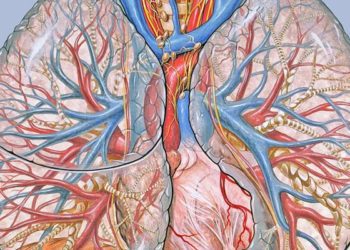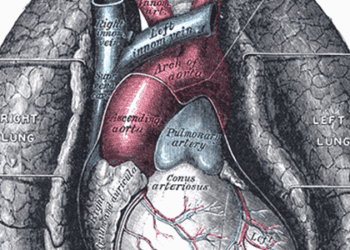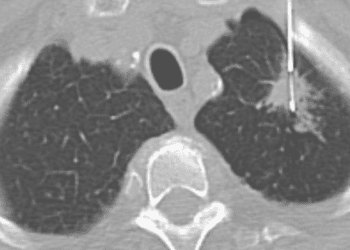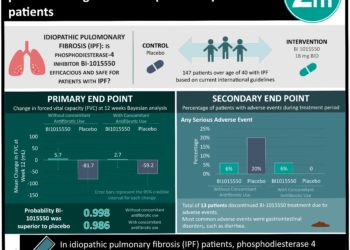Thyroid hormone supplementation may be a promising treatment for idiopathic pulmonary fibrosis [PreClinical]
1. An enzyme involved in thyroid hormone activation was found to be elevated in patients with pulmonary fibrosis.
2. Following the treatment of various mouse models of pulmonary fibrosis with thyroid hormone, mitochondrial function improved and signs of fibrosis decreased.
Evidence Rating Level: 2 (Good)
Study Rundown: Idiopathic pulmonary fibrosis (IPF) is a uniformly progressive lung disease with a median survival of only 3 years. Few treatment options exist for patients with IPF, though new treatment options may be on the horizon. The Lung Genomic Research Consortium (LGRC) recently published data demonstrating that expression levels of a gene called DIO2 correlated with IPF severity in human patients. This was also true in a commonly used bleomycin-induced fibrosis mouse model of the disease.
When DIO2 knockout mice were administered bleomycin, a greater increase in collagen deposition and fibrosis was observed relative to wild-type mice, suggesting that DIO2 has protective role in guarding against pathologic fibrosis. DIO2 is an enzyme involved in converting free T4 to T3. Thus, the authors hypothesized that an increase in T3 levels might be mediating DIO2’s protective effect. To test this hypothesis, the authors administered oral T3 to IPF mice. This therapy not only resulted in a decrease in fibrosis, but also increased survival. Due to the known role of thyroid hormone in modulating mitochondrial function, the mitochondria of alveolar epithelial cells (AECs) were evaluated with and without T3 treatment to determine whether any changes to this organelle occurred. T3 treatment resulted in the improvement of mitochondrial structure, as well as a partial restoration of oxygen consumption in AECs from IPF mice. Furthermore, decreased expression of apoptotic markers and reduced overall levels of cell death of AECs were observed following treatment with T3. These studies are the first to detail the efficacy and mechanism through which thyroid hormone can be used to treat IPF. Other studies will need to be performed to assess the efficacy of this treatment compared to current therapies, as well as to determine optimal doses and potential side effects.
Click to read the study in Nature Medicine
Relevant Reading: Recent advances in managing idiopathic pulmonary fibrosis
In-Depth [animal study]: The LGRC database identified significantly increased expression of DIO2 in the lungs of IPF patients and mice (p< 0.006). Dio2-/- mice were then administered 1.5 U/kg bleomycin, and histologic assessment of collagen deposition and fibrosis was performed. After bleomycin treatment, Dio2-/- demonstrated a 1.3 fold increase in hydroxyproline levels as well as increased fibrosis relative to wild-type litermates, suggesting DIO2s protective effects in IPF. Bleomycin-induced mice were then administered aerosolized T3 at 40 µg/kg every other day. Histology revealed decreased fibrosis development in these mice along with improved lung function through the Flexi-Vent system-SCIREQ (p< 0.001) relative to untreated littermates.
Electron microscopy was used to visualize the mitochondrial structure seen in AECs of treated and untreated IPF mice, with a reversal of membrane disruption and cristae damage noted with T3 treatment. An extracellular flux analyzer was used to evaluate the oxygen consumption rate of AECs from these mouse models, revealing a functional restoration of mitochondria following T3 treatment (p< 0.001).
Finally, mitochondria-regulated apoptosis was assessed through western blotting for apoptotic proteins along with TUNEL staining. IPF is associated with an increase of the ratio of proapoptotic to antiapoptotic proteins as well as increased TUNEL-positive apoptotic cells. However, mice treated with T3 showed a significant decrease in the pro- to anti- apoptotic protein ratio and fewer apoptotic cells (p< 0.001).
Image: PD
©2018 2 Minute Medicine, Inc. All rights reserved. No works may be reproduced without expressed written consent from 2 Minute Medicine, Inc. Inquire about licensing here. No article should be construed as medical advice and is not intended as such by the authors or by 2 Minute Medicine, Inc.





![PET scans in early-stage Hodgkin’s lymphoma may help guide therapy [RAPID trial]](https://www.2minutemedicine.com/wp-content/uploads/2015/04/1280px-Hodgkin_lymphoma_cytology_large-75x75.jpg)



